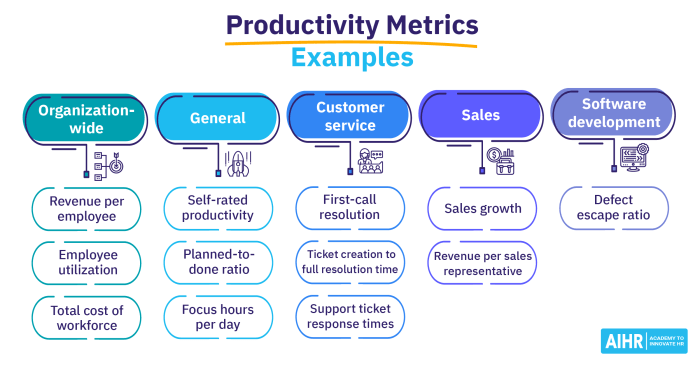How can data analytics improve the measurement of employees performance – In the contemporary business landscape, the advent of data analytics has emerged as a transformative force, revolutionizing the way organizations measure and evaluate employee performance. This article delves into the profound impact of data analytics on performance measurement, exploring the techniques, benefits, and ethical considerations associated with its application.
Data analytics empowers organizations to collect, analyze, and visualize vast amounts of data related to employee performance, enabling them to gain unprecedented insights into individual and team contributions. By leveraging statistical and qualitative analysis techniques, organizations can identify patterns, trends, and correlations that were previously hidden, leading to a more comprehensive and objective assessment of employee performance.
Data Collection and Measurement
Data analytics provides a powerful tool for collecting and measuring employee performance data. Various methods can be employed to gather this data, including:
- Surveys:Employee surveys allow organizations to collect feedback directly from employees on their performance, strengths, and areas for improvement.
- Performance appraisals:Regular performance appraisals provide structured feedback and ratings on employee performance, typically conducted by supervisors or managers.
- Key performance indicators (KPIs):KPIs are specific, measurable metrics that align with organizational goals and can be used to track employee performance.
- Behavioral observation:Supervisors or peers can observe employee behavior and document specific instances of performance, providing qualitative data.
The metrics used to measure employee performance vary depending on the industry, role, and organizational goals. Common metrics include:
- Productivity: Output or results achieved within a given time frame.
- Quality: Accuracy, completeness, and adherence to standards.
- Customer satisfaction: Feedback and ratings from customers.
- Teamwork and collaboration: Ability to work effectively with others.
li>Communication skills: Proficiency in conveying information clearly and effectively.
Data quality and accuracy are crucial for effective performance measurement. Organizations must ensure that data is collected and analyzed systematically, without bias or errors. Regular data validation and cleaning processes are essential to maintain data integrity.
Data Analysis Techniques: How Can Data Analytics Improve The Measurement Of Employees Performance

Data analytics employs a range of techniques to evaluate employee performance. Statistical methods provide quantitative insights, while qualitative methods offer a deeper understanding of employee perspectives.
Statistical Methods, How can data analytics improve the measurement of employees performance
Statistical methods, such as:
- Regression analysis:Examines the relationship between variables, allowing organizations to identify factors influencing employee performance.
- Correlation analysis:Assesses the strength and direction of the relationship between two or more variables, helping organizations understand how different factors interact.
- Time series analysis:Analyzes data over time to identify trends and patterns in employee performance.
Qualitative Methods
Qualitative methods, such as:
- Text analysis:Analyzes written feedback, such as employee comments or survey responses, to extract insights and identify common themes.
- Interviews:Conduct one-on-one or group interviews with employees to gather in-depth feedback and explore their perspectives.
- Focus groups:Facilitate group discussions with employees to gather collective insights and explore shared experiences.
Data Visualization and Reporting

Data visualization is a powerful tool for enhancing performance measurement. It allows organizations to present data in a visually appealing and easily understandable format, facilitating insights and decision-making.
| Visualization | Benefits |
|---|---|
| Dashboards | Provide a comprehensive overview of employee performance, with key metrics and trends displayed in a single view. |
| Charts and graphs | Illustrate trends, patterns, and relationships in employee performance data, making it easier to identify areas for improvement. |
| Heat maps | Visually represent the distribution of data, highlighting areas of high and low performance. |
| Infographics | Combine visual elements and data to create engaging and informative representations of employee performance. |
Effective data visualization enables organizations to quickly identify patterns, outliers, and trends in employee performance, leading to more informed decision-making and improved performance management.
Data-Driven Decision Making

Data analytics provides valuable insights that can inform decision-making about employee performance. By analyzing data, organizations can:
- Identify strengths and weaknesses:Data analytics can pinpoint areas where employees excel and areas where they need support.
- Set performance goals:Data-driven analysis can help organizations establish realistic and achievable performance goals based on employee capabilities and organizational objectives.
- Provide feedback:Data analytics enables organizations to provide employees with specific, data-backed feedback on their performance, helping them understand their strengths and areas for improvement.
- Make informed decisions:Data analytics provides a solid foundation for making informed decisions about employee training, development, and performance management.
Data-driven decision-making empowers organizations to manage employee performance more effectively, leading to improved productivity, employee engagement, and organizational success.
Ethical Considerations

While data analytics offers significant benefits, it also raises ethical considerations that organizations must address.
- Privacy:Organizations must ensure that employee performance data is collected and used ethically, respecting employee privacy.
- Bias:Data analytics algorithms can perpetuate existing biases in performance measurement, leading to unfair or discriminatory outcomes.
- Fairness:Organizations must use data analytics fairly and equitably, ensuring that all employees are evaluated on the same criteria and without bias.
Organizations should establish clear guidelines and policies to ensure the ethical use of data analytics in employee performance measurement. These guidelines should address data collection, storage, analysis, and reporting, as well as employee rights and protections.
Essential Questionnaire
How does data analytics improve data quality in performance measurement?
Data analytics enables organizations to cleanse, validate, and transform raw data into high-quality information, ensuring the accuracy and reliability of performance metrics.
What are the ethical considerations related to using data analytics in employee performance measurement?
Organizations must consider issues such as privacy, bias, and fairness when collecting, analyzing, and using employee performance data. Clear guidelines and ethical frameworks are essential to protect employee rights and maintain trust.